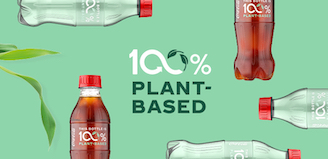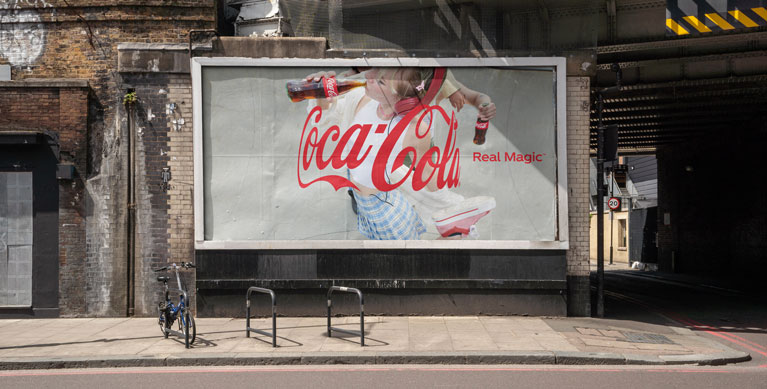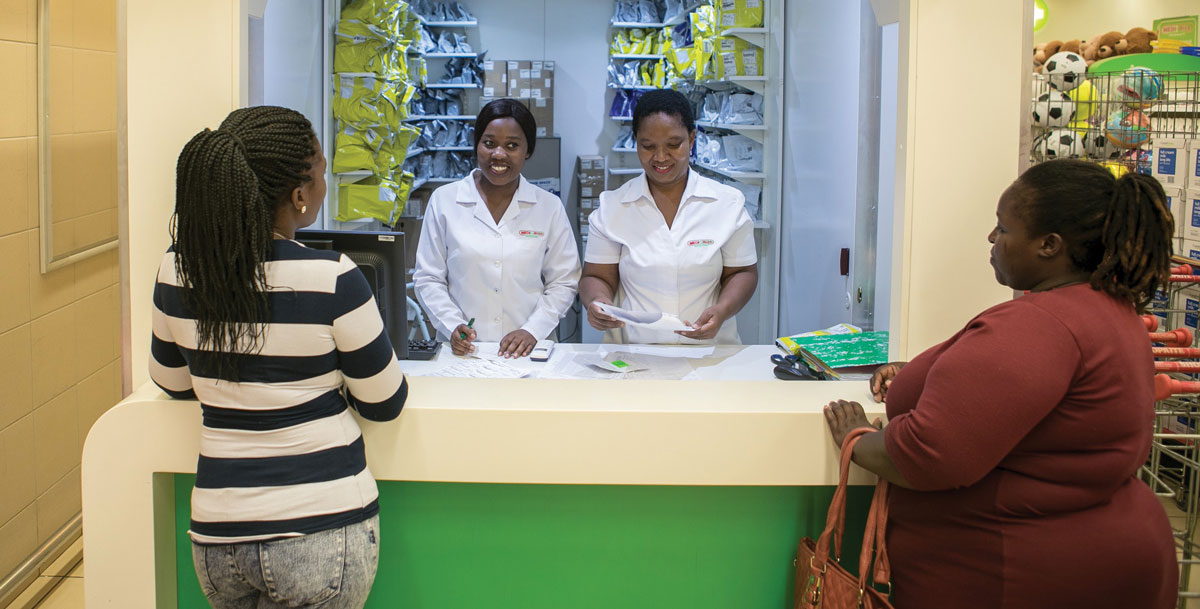Coca‑Cola Reports Second Quarter 2021 Results
07-21-2021
Coca‑Cola Reports Strong Results in Second Quarter;
Updates Full Year Guidance
Global Unit Case Volume Grew 18%
Net Revenues Grew 42%;
Organic Revenues (Non-GAAP) Grew 37%
Operating Income Grew 52%;
Comparable Currency Neutral Operating Income (Non-GAAP) Grew 46%
Operating Margin Was 29.8% Versus 27.7% in the Prior Year;
Comparable Operating Margin (Non-GAAP) Was 31.7% Versus 30.0% in the Prior Year
EPS Grew 48% to $0.61; Comparable EPS (Non-GAAP) Grew 61% to $0.68
ATLANTA, July 21, 2021 – The Coca‑Cola Company today reported strong second quarter 2021 results and year-to-date performance. “Our results in the second quarter show how our business is rebounding faster than the overall economic recovery, led by our accelerated transformation. As a result, we are encouraged and, despite the asynchronous nature of the recovery, we are raising our full year guidance,” said James Quincey, Chairman and CEO of The Coca‑Cola Company. “We are executing against our growth plans and our system is aligned. We are better equipped than ever to win in this growing, vibrant industry and to accelerate value creation for our stakeholders.”
Highlights
Quarterly Performance
- Revenues: Net revenues grew 42% to $10.1 billion, and organic revenues (non-GAAP) grew 37%. Revenue performance included 26% growth in concentrate sales and 11% growth in price/mix. Revenue growth was driven by the ongoing recovery in markets where coronavirus-related uncertainty is abating, along with the benefit from cycling revenue declines from the impact of the coronavirus pandemic last year.
- Margin: Operating margin, which included items impacting comparability, was 29.8% versus 27.7% in the prior year, while comparable operating margin (non-GAAP) was 31.7% versus 30.0% in the prior year. Operating margin expansion was primarily driven by favorable channel and package mix where coronavirus-related uncertainty is abating, partially offset by a significant increase in marketing expenses versus the prior year.
- Earnings per share: EPS grew 48% to $0.61, and comparable EPS (non-GAAP) grew 61% to $0.68. Comparable EPS (non-GAAP) growth included the impact of a 5-point currency tailwind.
- Market share: The company gained value share in total nonalcoholic ready-to-drink (NARTD) beverages driven by a share gain in both at-home and away-from-home channels. The company’s value share in total NARTD beverages is now ahead of the 2019 level.
- Cash flow: Year-to-date cash flow from operations was $5.5 billion, up $2.7 billion versus the prior year, driven by strong business performance, five additional days in the first quarter and working capital initiatives. Year-to-date free cash flow (non-GAAP) was $5.1 billion, up $2.8 billion versus the prior year, driven by cash flow from operations along with lower capital expenditures versus the prior year.
Company Updates
- Business environment update: Global unit case volume benefited from the ongoing recovery in many markets, partially offset by the impact of a resurgence of the coronavirus in several markets. As a result, when compared to 2019 volume levels, second quarter volume growth was in line with the first quarter of 2021. The company saw away-from-home channels rebound as restrictions eased in certain markets, driving value across the enterprise and leading to second quarter revenues ahead of the 2019 level. While coronavirus-related uncertainty continues, the company remains agile in order to execute on its strategic priorities and build on the work that has been done in the past year to navigate an asynchronous recovery.
- Continuing innovation through loved and scaled brands: The company, with its disciplined approach to scaling big bets, recently announced the launch of a new and improved Coca‑Cola® Zero Sugar recipe in the United States that brings it closer to the great taste of original Coca‑Cola. New packaging is simplified and celebrates the iconic Coca‑Cola logo, beginning with the brand’s universally recognized red. The Coca‑Cola logo in black Spencerian script signals the Zero Sugar variety. The new, global marketing approach for Coca‑Cola Zero Sugar will be supported by scaled advertisements and a 360-degree marketing activation plan that invites consumers to try the product and find out if it’s the “Best Coke® Ever?” The new Coca‑Cola Zero Sugar previously launched in five operating units across multiple countries, including Japan, Turkey, parts of Latin America and parts of Europe. Overall, Coca‑Cola Zero Sugar grew 15% year-to-date, resulting in high single-digit growth versus 2019.
- Transforming the digital ecosystem to create and capture value: The company is leveraging the strength of the Coca‑Cola system to drive value for stakeholders. The Wabi™ ecosystem, which leverages the system’s unrivaled distribution network and connects businesses to businesses to consumers, continues to accelerate and is now present in 14 countries, with gross merchandising value growing significantly. The company’s footprint in e-commerce also continues to expand. The company’s direct-to-consumer Coke ON® app in Japan, which connects consumers to the system’s vending machines, reached more than 28 million downloads with significant gains in consumer awareness versus the prior year. In North America e-commerce retail, the company continues to be the market leader in the total NARTD category, growing retail value 54% year-to-date. In Europe, our e-commerce is growing retail value faster than 50% across key markets, resulting in a strong value share gain year-to-date.
- Accelerating sustainable business practices: During the quarter, the company continued its sustainability journey, which included announcing its plans to use 100% recycled plastic (rPET) in all on-the-go bottles across its portfolio in Great Britain beginning in September, and announcing that by the end of summer all locally manufactured packages in Belgium and Luxembourg are expected to be 100% rPET. These initiatives will save approximately 43,000 tonnes of virgin plastic each year. The company also announced a partnership with The Ocean Cleanup to help stem the tide of marine waste by intercepting plastic debris in rivers around the world. The partnership brings together the company’s scale and global network with The Ocean Cleanup’s technology and data-driven solutions to address 15 rivers by the end of 2022. Finally, the company continued its multi-faceted approach to diversity, equity and inclusion by announcing plans to nearly double its spending with minority-owned media companies in North America over the next three years.
Operating Review – Three Months Ended July 2, 2021
Revenues and Volume

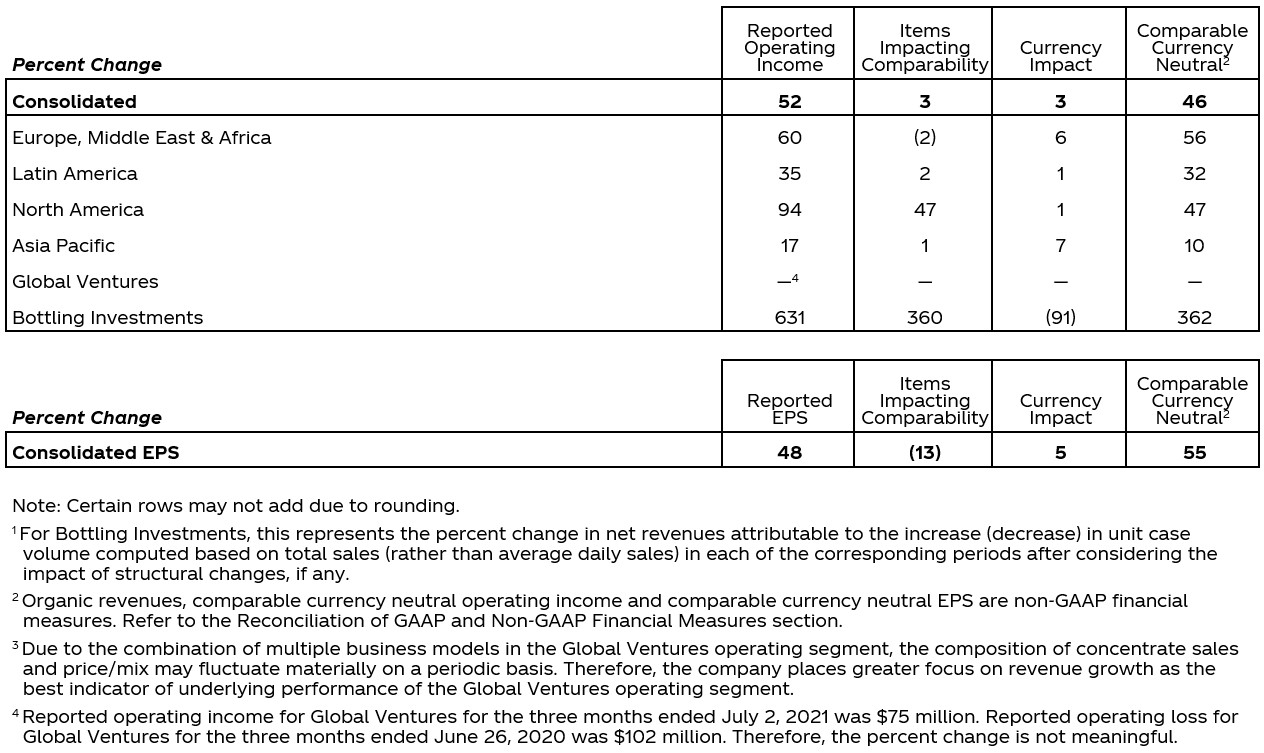
In addition to the data in the preceding tables, operating results included the following:
Consolidated
- Unit case volume grew 18% in the quarter, resulting in even performance on a two-year basis, driven by the ongoing recovery in markets where coronavirus-related uncertainty is abating along with the benefit from cycling the impact of the coronavirus pandemic last year. Both developed and developing and emerging markets led the recovery, and both grew double digits in the quarter. Markets such as China, Brazil and Nigeria grew volume ahead of 2019 levels while other markets, including India, continued to be under pressure versus 2019, driven by the continued impact of the coronavirus pandemic.
Category performance was as follows:
- Sparkling soft drinks grew 14%, led by strong growth in the United States, India and Brazil. Trademark Coca‑Cola grew 12%, resulting in volume ahead of the 2019 level, led by Europe, Middle East & Africa and Latin America. Sparkling flavors grew 18%, led by solid growth in both Trademark Sprite and Trademark Fanta.
- Nutrition, juice, dairy and plant-based beverages grew 25% due to solid performance by Minute Maid® and fairlife® in North America, Minute Maid Pulpy in China and Maaza® in India.
- Hydration, sports, coffee and tea grew 25%. Hydration grew 21%, with double-digit growth across all geographic operating segments. Sports drinks grew 35%, resulting in volume ahead of the 2019 level, primarily driven by Powerade® in North America. Tea grew 18%, led by growth in the United States, Japan and Brazil. Coffee grew 78%, primarily driven by the reopening of Costa® retail stores in the United Kingdom as coronavirus-related uncertainty continued to abate.
- Price/mix grew 11% for the quarter, primarily driven by favorable channel and package mix due to cycling the impact of the coronavirus pandemic last year, along with positive segment mix from Global Ventures and Bottling Investments. Concentrate sales were 9 points ahead of unit case volume in the quarter, primarily due to cycling the rationalization of stock levels in the prior year along with the timing of shipments in the current year. Year-to-date concentrate sales were 6 points ahead of unit case volume primarily due to five additional days in the first quarter, along with cycling the timing of shipments in the prior year.
- Operating income grew 52%, which included items impacting comparability and a 5-point currency tailwind. Comparable currency neutral operating income (non-GAAP) grew 46%, driven by strong organic revenue (non-GAAP) growth across all operating segments, partially offset by a significant increase in marketing expenses versus the prior year.
Europe, Middle East & Africa
- Unit case volume grew 21% in the quarter, driven by the ongoing recovery in markets where coronavirus-related uncertainty is abating, along with the benefit from cycling the impact of the coronavirus pandemic last year. Growth was led by Russia, Spain and Germany in Europe, Nigeria in Africa, and Turkey and Pakistan in Eurasia and Middle East.
- Price/mix grew 20% for the quarter, driven by favorable channel and package mix due to cycling the impact of the coronavirus pandemic last year, along with the timing of deductions. For the quarter, concentrate sales were 20 points ahead of unit case volume due to cycling the rationalization of stock levels in the prior year, along with the timing of shipments in the current year. Year-to-date concentrate sales were 9 points ahead of unit case volume primarily due to five additional days in the first quarter, along with cycling the timing of shipments in the prior year.
- Operating income grew 60%, which included items impacting comparability and a currency tailwind. Comparable currency neutral operating income (non-GAAP) grew 56%, primarily driven by strong organic revenue (non-GAAP) growth across all operating units, partially offset by a significant increase in marketing expenses versus the prior year.
- The company gained value share in total NARTD beverages along with gaining or maintaining share across all categories.
Latin America
- Unit case volume grew 12% in the quarter, resulting in volume ahead of the 2019 level, primarily driven by the ongoing recovery in away-from-home channels and continued strength in at-home channels. Growth was led by Brazil and Mexico, driven by solid performance of sparkling soft drinks and the hydration category.
- Price/mix grew 9%, driven by pricing initiatives along with favorable channel and package mix. For the quarter, concentrate sales were 17 points ahead of unit case volume due to cycling the rationalization of stock levels in the prior year, along with the timing of shipments in the current year. Year-to-date concentrate sales were 8 points ahead of unit case volume primarily due to five additional days in the first quarter, along with the timing of shipments in the current year.
- Operating income grew 35%, which included items impacting comparability and a 1-point currency tailwind. Comparable currency neutral operating income (non-GAAP) grew 32%, driven by solid organic revenue (non-GAAP) growth, partially offset by a significant increase in marketing expenses versus the prior year.
- The company lost value share in total NARTD beverages as share gains in Brazil and Argentina were more than offset by share losses in Mexico and Ecuador.
North America
- Unit case volume grew 17% in the quarter. Growth was led by the recovery in the fountain business across all categories as coronavirus-related uncertainty continued to abate during the quarter. At-home channel strength continued during the quarter, and at-home channels continued to see volume ahead of 2019 levels.
- Price/mix grew 12% for the quarter, primarily driven by the recovery in the fountain business and away-from-home channels, along with solid growth in premium offerings and juice and dairy finished-goods brands. Year-to-date concentrate sales were 3 points ahead of unit case volume, primarily due to five additional days in the first quarter.
- Operating income grew 94%, which included tailwinds from items impacting comparability and currency. Comparable currency neutral operating income (non-GAAP) grew 47%, driven by strong organic revenue (non-GAAP) growth, partially offset by a significant increase in marketing expenses versus the prior year.
- The company gained value share in total NARTD beverages led by a strong recovery in away-from-home channels along with continued strong performance in at-home channels.
Asia Pacific
- Unit case volume grew 16% in the quarter, driven by growth across all operating units due to the ongoing recovery in markets where coronavirus-related uncertainty is abating, along with the benefit from cycling the impact of the coronavirus pandemic last year. Growth was led by sparkling flavors and the hydration category.
- Price/mix grew 6%, driven by favorable channel and package mix due to cycling the impact of the coronavirus pandemic last year, along with the timing of deductions. Year-to-date concentrate sales were 5 points ahead of unit case volume, primarily due to five additional days in the first quarter.
- Operating income grew 17%, which included a 7-point currency tailwind. Comparable currency neutral operating income (non-GAAP) grew 10%, driven by solid organic revenue (non-GAAP) growth, partially offset by a significant increase in marketing expenses versus the prior year.
- The company gained value share in total NARTD beverages driven by share gains in Japan and Southeast Asia.
Global Ventures
- Net revenues grew 139% in the quarter, which included a 23-point currency tailwind. Organic revenues (non-GAAP) grew 117%. Revenue growth was primarily driven by the reopening of Costa retail stores in the United Kingdom as coronavirus-related uncertainty continued to abate.
- Operating income growth and comparable currency neutral operating income (non-GAAP) growth were driven by strong organic revenue (non-GAAP) growth.
Bottling Investments
- Unit case volume grew 25% in the quarter, primarily driven by solid growth in India and South Africa.
- Price/mix grew 3%, driven by pricing and trade promotion optimization in most markets, along with a benefit from category and package mix.
- Operating income growth of 631% included a tailwind from items impacting comparability and a headwind from currency. Comparable currency neutral operating income (non-GAAP) grew 362%, driven by solid organic revenue (non-GAAP) growth along with effective cost management.
Operating Review – Six Months Ended July 2, 2021
Revenues and Volume

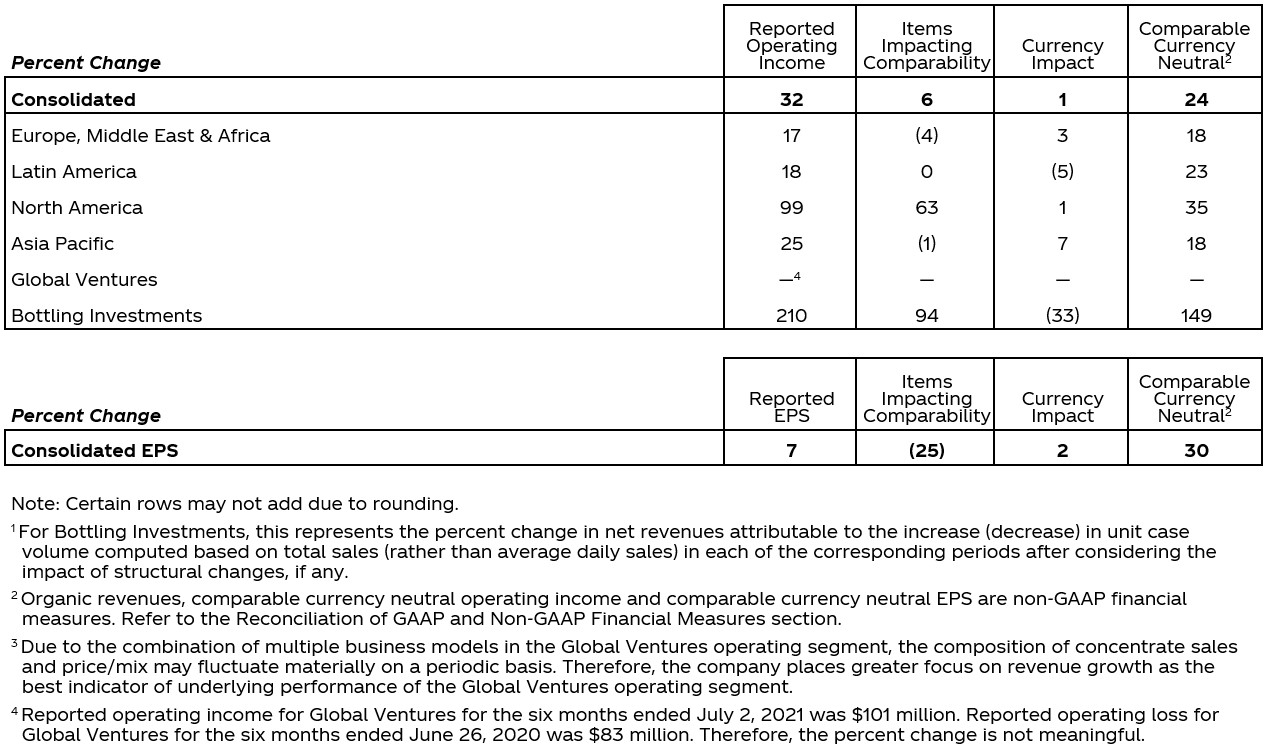
Outlook
The 2021 outlook information provided below includes forward-looking non-GAAP financial measures, which management uses in measuring performance. The company is not able to reconcile full year 2021 projected organic revenues (non-GAAP) to full year 2021 projected reported net revenues, full year 2021 projected comparable net revenues (non-GAAP) to full year 2021 projected reported net revenues, full year 2021 projected underlying effective tax rate (non-GAAP) to full year 2021 projected reported effective tax rate, or full year 2021 projected comparable EPS (non-GAAP) to full year 2021 projected reported EPS without unreasonable efforts because it is not possible to predict with a reasonable degree of certainty the actual impact of changes in foreign currency exchange rates; the exact timing and amount of acquisitions, divestitures and/or structural changes; and the exact timing and amount of items impacting comparability throughout 2021. The unavailable information could have a significant impact on the company’s full year 2021 reported financial results.
Full Year 2021
The company expects to deliver organic revenue (non-GAAP) growth of 12% to 14%. – Updated
For comparable net revenues (non-GAAP), the company expects a 1% to 2% currency tailwind based on the current rates and including the impact of hedged positions. – Unchanged
The company’s underlying effective tax rate (non-GAAP) is estimated to be 19.1%. This does not include the impact of the ongoing tax litigation with the U.S. Internal Revenue Service, if the company were not to prevail. – Unchanged
Given the above considerations, the company expects to deliver comparable EPS (non-GAAP) growth of 13% to 15% versus $1.95 in 2020. – Updated
Comparable EPS (non-GAAP) percentage growth includes a 2% to 3% currency tailwind based on the current rates and including the impact of hedged positions. – Unchanged
The company expects to generate free cash flow (non-GAAP) of at least $9.0 billion through cash flow from operations of at least $10.5 billion less capital expenditures of approximately $1.5 billion. This does not include any potential payments related to the ongoing tax litigation with the U.S. Internal Revenue Service. – Updated
Third Quarter 2021 Considerations
Comparable net revenues (non-GAAP) are expected to include an approximate 2% currency tailwind based on the current rates and including the impact of hedged positions.
Comparable EPS (non-GAAP) is expected to include an approximate 3% to 4% currency tailwind based on the current rates and including the impact of hedged positions.
Notes
- All references to growth rate percentages and share compare the results of the period to those of the prior year comparable period, unless otherwise noted.
- All references to volume and volume percentage changes indicate unit case volume, unless otherwise noted. All volume percentage changes are computed based on average daily sales, unless otherwise noted. “Unit case” means a unit of measurement equal to 192 U.S. fluid ounces of finished beverage (24 eight-ounce servings), with the exception of unit case equivalents for Costa non-ready-to-drink beverage products which are primarily measured in number of transactions. “Unit case volume” means the number of unit cases (or unit case equivalents) of company beverages directly or indirectly sold by the company and its bottling partners to customers or consumers.
- “Concentrate sales” represents the amount of concentrates, syrups, beverage bases, source waters and powders/minerals (in all instances expressed in equivalent unit cases) sold by, or used in finished beverages sold by, the company to its bottling partners or other customers. For Costa non-ready-to-drink beverage products, “concentrate sales” represents the amount of coffee beans (in all instances expressed in equivalent unit cases) sold by the company to customers or consumers. In the reconciliation of reported net revenues, “concentrate sales” represents the percent change in net revenues attributable to the increase (decrease) in concentrate sales volume for the geographic operating segments and the Global Ventures operating segment after considering the impact of structural changes, if any. For the Bottling Investments operating segment, this represents the percent change in net revenues attributable to the increase (decrease) in unit case volume computed based on total sales (rather than average daily sales) in each of the corresponding periods after considering the impact of structural changes, if any. The Bottling Investments operating segment reflects unit case volume growth for consolidated bottlers only.
- “Price/mix” represents the change in net operating revenues caused by factors such as price changes, the mix of products and packages sold, and the mix of channels and geographic territories where the sales occurred.
- First quarter 2021 financial results were impacted by five additional days as compared to first quarter 2020, and fourth quarter 2021 financial results will be impacted by six fewer days as compared to fourth quarter 2020. Unit case volume results for the quarters are not impacted by the variances in days due to the average daily sales computation referenced above.
Conference Call
The company is hosting a conference call with investors and analysts to discuss second quarter 2021 operating results today, July 21, 2021, at 8:30 a.m. ET. The company invites participants to listen to a live webcast of the conference call on the company’s website, in the “Investors” section, at https://investors.coca-colacompany.com. An audio replay in downloadable digital format and a transcript of the call will be available on the website within 24 hours following the call. Further, the “Investors” section of the website includes certain supplemental information and a reconciliation of non-GAAP financial measures to the company’s results as reported under GAAP, which may be used during the call when discussing financial results.
Forward-Looking Statements
This press release may contain statements, estimates or projections that constitute “forward-looking statements” as defined under U.S. federal securities laws. Generally, the words “believe,” “expect,” “intend,” “estimate,” “anticipate,” “project,” “will” and similar expressions identify forward-looking statements, which generally are not historical in nature. Forward-looking statements are subject to certain risks and uncertainties that could cause The Coca‑Cola Company’s actual results to differ materially from its historical experience and our present expectations or projections. These risks include, but are not limited to, the negative impacts of the COVID-19 pandemic on our business; an inability to realize the economic benefits from our productivity initiatives, including our reorganization and related strategic realignment initiatives; an inability to attract or retain a highly skilled and diverse workforce; increased competition; an inability to renew collective bargaining agreements on satisfactory terms, or we or our bottling partners experience strikes, work stoppages or labor unrest; an inability to be successful in our innovation activities; changes in the retail landscape or the loss of key retail or foodservice customers; an inability to expand operations in emerging and developing markets; increased cost, disruption of supply or shortage of energy or fuel; increased cost, disruption of supply or shortage of ingredients, other raw materials, packaging materials, aluminum cans and other containers; an inability to successfully manage new product launches; obesity and other health related concerns; evolving consumer product and shopping preferences; product safety and quality concerns; perceived negative health consequences of certain ingredients, such as non-nutritive sweeteners and biotechnology-derived substances, and of other substances present in our beverage products or packaging materials; damage to our brand image, corporate reputation and social license to operate from negative publicity, whether or not warranted, concerning product safety or quality, workplace and human rights, obesity or other issues; an inability to maintain good relationships with our bottling partners; deterioration in our bottling partners’ financial condition; an inability to successfully integrate and manage consolidated bottling operations or other acquired businesses or brands; an inability to successfully manage our refranchising activities; increases in income tax rates, changes in income tax laws or the unfavorable resolution of tax matters, including the outcome of our ongoing tax dispute or any related disputes with the U.S. Internal Revenue Service (“IRS”); the possibility that the assumptions used to calculate our estimated aggregate incremental tax and interest liability related to the potential unfavorable outcome of the ongoing tax dispute with the IRS could significantly change; increased or new indirect taxes in the United States and throughout the world; changes in laws and regulations relating to beverage containers and packaging; significant additional labeling or warning requirements or limitations on the marketing or sale of our products; litigation or legal proceedings; conducting business in markets with high-risk legal compliance environments; failure to adequately protect, or disputes relating to, trademarks, formulae and other intellectual property rights; changes in, or failure to comply with, the laws and regulations applicable to our products or our business operations; fluctuations in foreign currency exchange rates; interest rate increases; unfavorable general economic conditions in the United States and international markets; an inability to achieve our overall long-term growth objectives; default by or failure of one or more of our counterparty financial institutions; impairment charges; failure to realize a significant portion of the anticipated benefits of our strategic relationship with Monster Beverage Corporation; an inability to protect our information systems against service interruption, misappropriation of data or breaches of security; failure to comply with personal data protection and privacy laws; failure to digitize the Coca‑Cola system; failure by our third-party service providers and business partners to satisfactorily fulfill their commitments and responsibilities; increasing concerns about the environmental impact of plastic bottles and other plastic packaging materials; water scarcity and poor quality; increased demand for food products and decreased agricultural productivity; climate change and legal or regulatory responses thereto; adverse weather conditions; and other risks discussed in our filings with the Securities and Exchange Commission (the “SEC”), including our Annual Report on Form 10-K for the year ended December 31, 2020, which filings are available from the SEC. You should not place undue reliance on forward-looking statements, which speak only as of the date they are made. We undertake no obligation to publicly update or revise any forward-looking statements.
